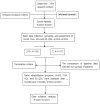Early Rehabilitation Exercise after Stroke Improves Neurological Recovery through Enhancing Angiogenesis in Patients and Cerebral Ischemia Rat Model
- PMID: 36142421
- PMCID: PMC9499642
- DOI: 10.3390/ijms231810508
Early Rehabilitation Exercise after Stroke Improves Neurological Recovery through Enhancing Angiogenesis in Patients and Cerebral Ischemia Rat Model
Abstract
Among cerebrovascular diseases, ischemic stroke is a leading cause of mortality and disability. Thrombolytic therapy with tissue plasminogen activator is the first choice for clinical treatment, but its use is limited due to the high requirements of patient characteristics. Therefore, the choice of neurological rehabilitation strategies after stroke is an important prevention and treatment strategy to promote the recovery of neurological function in patients. This study shows that rehabilitation exercise 24 h after stroke can significantly improve the neurological function (6.47 ± 1.589 vs. 3.21 ± 1.069 and 0.76 ± 0.852), exercise ability (15.68 ± 5.95 vs. 162.32 ± 9.286 and 91.18 ± 7.377), daily living ability (23.37 ± 5.196 vs. 66.95 ± 4.707 and 6.55 ± 2.873), and quality of life (114.39 ± 7.772 vs. 168.61 ± 6.323 and 215.95 ± 10.977) of patients after 1 month and 3 months, and its ability to promote rehabilitation is better than that of rehabilitation exercise administered to patients 72 h after stroke (p < 0.001). Animal experiments show that treadmill exercise 24 h after middle cerebral artery occlusion and reperfusion can inhibit neuronal apoptosis, reduce the volume of cerebral infarction on the third (15.04 ± 1.07% vs. 30.67 ± 3.06%) and fifth (8.33 ± 1.53% vs. 30.67 ± 3.06%) days, and promote the recovery of neurological function on the third (7.22 ± 1.478 vs. 8.28 ± 1.018) and fifth (4.44 ± 0.784 vs. 6.00 ± 0.767) days. Mechanistic studies have shown that treadmill exercise increases the density of microvessels, regulates angiogenesis, and promotes the recovery of nerve function by upregulating the expression of vascular endothelial growth factor and laminin. This study shows that rehabilitation exercise 24 h after stroke is conducive to promoting the recovery of patients’ neurological function, and provides a scientific reference for the clinical rehabilitation of stroke patients.
Keywords: angiogenesis; early rehabilitation; neurological function; stroke.
Conflict of interest statement
The authors declare no conflict of interest.
Figures





Similar articles
-
Role of caveolin-1/vascular endothelial growth factor pathway in basic fibroblast growth factor-induced angiogenesis and neurogenesis after treadmill training following focal cerebral ischemia in rats.Brain Res. 2017 May 15;1663:9-19. doi: 10.1016/j.brainres.2017.03.012. Epub 2017 Mar 12. Brain Res. 2017. PMID: 28300551
-
Effects of Treadmill Exercise on Motor and Cognitive Function Recovery of MCAO Mice Through the Caveolin-1/VEGF Signaling Pathway in Ischemic Penumbra.Neurochem Res. 2019 Apr;44(4):930-946. doi: 10.1007/s11064-019-02728-1. Epub 2019 Jan 19. Neurochem Res. 2019. PMID: 30661230
-
Exercise preconditioning reduces brain damage and inhibits TNF-alpha receptor expression after hypoxia/reoxygenation: an in vivo and in vitro study.Curr Neurovasc Res. 2006 Nov;3(4):263-71. doi: 10.2174/156720206778792911. Curr Neurovasc Res. 2006. PMID: 17109621
-
Nuclear medicine in the rehabilitative treatment evaluation in stroke recovery. Role of diaschisis resolution and cerebral reorganization.Eura Medicophys. 2007 Jun;43(2):221-39. Epub 2007 Feb 1. Eura Medicophys. 2007. PMID: 17268387 Review.
-
Angiogenesis after ischemic stroke.Acta Pharmacol Sin. 2023 Jul;44(7):1305-1321. doi: 10.1038/s41401-023-01061-2. Epub 2023 Feb 24. Acta Pharmacol Sin. 2023. PMID: 36829053 Free PMC article. Review.
Cited by
-
Effects of Different Intensities of Endurance Training on Neurotrophin Levels and Functional and Cognitive Outcomes in Post-Ischaemic Stroke Adults: A Randomised Clinical Trial.Int J Mol Sci. 2025 Mar 20;26(6):2810. doi: 10.3390/ijms26062810. Int J Mol Sci. 2025. PMID: 40141452 Free PMC article. Clinical Trial.
-
Effectiveness of lower limb robotic rehabilitation on peak of oxygen uptake among patients with stroke: a systematic review and meta-analysis.BMJ Open. 2024 Oct 17;14(10):e082985. doi: 10.1136/bmjopen-2023-082985. BMJ Open. 2024. PMID: 39419612 Free PMC article.
-
Environmental enrichment: a neurostimulatory approach to aging and ischemic stroke recovery and rehabilitation.Biogerontology. 2025 Apr 16;26(3):92. doi: 10.1007/s10522-025-10232-z. Biogerontology. 2025. PMID: 40237879 Review.
-
Transcutaneous auricular vagus nerve stimulation enhances structural and functional remodeling in sensorimotor networks following intracerebral hemorrhage in rats.J Neuroeng Rehabil. 2025 Jul 21;22(1):170. doi: 10.1186/s12984-025-01700-1. J Neuroeng Rehabil. 2025. PMID: 40691625 Free PMC article.
-
Causal effects of gut microbiota on the prognosis of ischemic stroke: evidence from a bidirectional two-sample Mendelian randomization study.Front Microbiol. 2024 Apr 8;15:1346371. doi: 10.3389/fmicb.2024.1346371. eCollection 2024. Front Microbiol. 2024. PMID: 38650876 Free PMC article.
References
-
- Zhang T., Zhao J., Li X., Bai Y., Wang B., Qu Y., Li B., Zhao S. Chinese Stroke Association Stroke Council Guideline Writing Committee. Chinese Stroke Association guidelines for clinical management of cerebrovascular disorders: Executive summary and 2019 update of clinical management of stroke rehabilitation. Stroke Vasc. Interv. Neurol. 2020;5:250–259. doi: 10.1136/svn-2019-000321. - DOI - PMC - PubMed
-
- Nesin S.M., Sabitha K.R., Gupta A., Laxmi T.R. Constraint Induced Movement Therapy as a Rehabilitative Strategy for Ischemic Stroke-Linking Neural Plasticity with Restoration of Skilled Movements. J. Stroke Cerebrovasc. Dis. 2019;28:1640–1653. doi: 10.1016/j.jstrokecerebrovasdis.2019.02.028. - DOI - PubMed
MeSH terms
Substances
Grants and funding
- 81871856/National Natural Science Foundation of China
- 222102310434, 222102310315/Henan Province Science and Technology Research and Development
- 20B180003/Foundation for University Key from the Ministry of Education of Henan Province
- 20221014003,20221014008/Innovation and entrepreneurship training program for college students of Henan University
LinkOut - more resources
Full Text Sources
Medical

